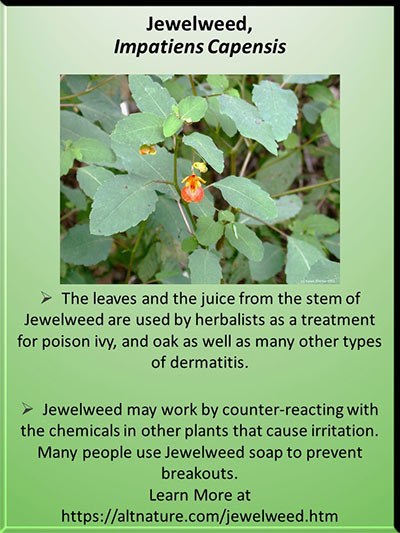Jewelweed, Nature's Answer to Poison Ivy
Learn to identify, find and use Jewelweed for Poison Ivy here.
Jewelweed is a wild plant native to North America. Jewelweed and preparations from the plant have been used for hundreds of years by Native Americans, herbalists and pioneers for easing irritation from Poison Ivy, Oak, Ringworm, Acne. Athlete's Foot, Bug bites and other skin rashes.
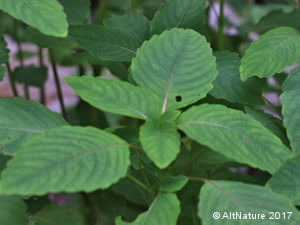
Where to Find Jewelweed
There are many different Impatiens species known as Jewelweed with flowers of purple, yellow, pink and white, sometimes a showy scarlet. The flowers are spurred and irregular in form and are borne in the leaf axils. This article is about the Impatiens capensis plant known as Orange Jewelweed, Spotted Jewelweed or Wild Touch-me-nots.
Orange Jewelweed is a smooth annual plant that grows to 3-5 ft or sometimes taller in the eastern part of North America from Southern Canada to the northern part of Florida. It is also now found in the Pacific Northwest states . USDA Distribution Map for Jewelweed
Wild Jewelweed is most often found on the edge of moist woods, along creeks, ditches and roadsides, sometimes with Poison Ivy, Nettles, and Perilla. It prefers shady, wet habitats. They often grow in large groups of plants. It's uncommon to find a single Jewelweed plant growing alone.
How to Identify Jewelweed
Orange Jewelweed plants are easy to spot in late summer, when they are loaded with cone-shaped orange flowers. They will begin to bloom in May or June , and continue until the plants are killed by a hard frost. Jewelweed is most showy in August and early September in the Southern United States and is often seen blooming profusely on wooded roadsides
Jewelweed leaves are oval, round- toothed, and smooth; the lower leaves are opposite on the stems, and the upper leaves are alternate. Jewelweed flowers hang from the plant much as a jewel from a necklace. Pale Jewelweed has yellow flowers, Spotted Touch-Me-Nots have orange flowers with dark red dots. It is pretty hard to tell them apart before they bloom. Yellow Jewelweed often gets taller, and is visible earlier in the season than Orange Jewelweed.

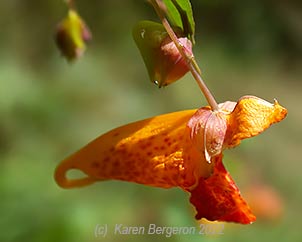
Jewelweed seed pods will 'pop out' when touched , that is where the name Touch-Me-Nots came from. Each pod contains 2-5 seeds. Although the plant self-seeds profusely, it isn't easy to harvest them as they eject forcefully. Be careful, they can hit you in the eye!
Jewelweed also has less some visible flowers. The following is from the US Forest Service "These flowers (termed cleistogamous by botanists) fertilize themselves and produce seed without ever exchanging pollen with another flower. Cleistogamous flowers are very small (about 1 mm long) and are borne near the bases of the leaves. Research has shown that seeds produced by the showy, cross-pollinated flowers grow into larger, hardier plants, but the cleistogamous flowers produce seed at a much lower cost to the parent plant." (Update 9/4.2022) The US Forest service has made site changes and the link I had posted no longer works.
Impatiens Capensis Meerb Integrated Taxonomic Information System - Report
Extensive Description of the Jewelweed Plant and Role in Environment
Jewelweed plants are often knocked down by rushing water and can sometimes be found with much off the stem on the ground, growing new roots at the leaf nodes, while new branches grow upward toward the light.
Harvesting Jewelweed
In early summer, Jewelweed's tender branches will ooze a gel-like substance when crushed or broken. At this stage, people who use Jewelweed for Poison Ivy or Oak will often pick the whole plant and use its juice.
As with most herbs, the best time to harvest Jewelweed is when it first begins to flower. Once the plant begins to flower, the main stems grow tougher and fibrous. Don't bother harvesting large branches when they get hard, after flowering begins. Cut the off tops of the plants for the small juicy branches, flowers and leaves.
When the stems grow hard, the leaves are more vulnerable to fungus and disease as they push energy into flower and seed production. However, if you see healthy, green leaves, you should have good results using the plant at later stages of growth.
FORAGING JEWELWEED SEED PODS (TASTES LIKE WALNUTS!) External Link.
It is commonly said that wherever you find Poison Ivy, you will find Jewelweed - however this is not always true as Jewelweed will not grow in dry places for long, and does not thrive in direct sunlight. Poison Ivy will grow in sun or shade, and does not require as much water to thrive. So while you are likely to find Poison Ivy growing near Jewelweed, the opposite isn't necessarily true.
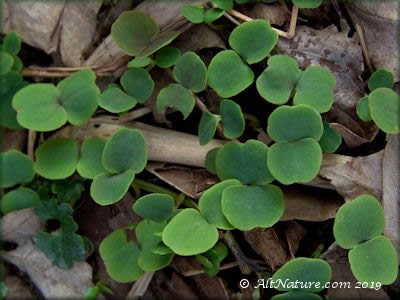
Read on to learn to make your own Poison Ivy treatment ice cubes with
Jewelweed.
How to Use Jewelweed
DisclaimerThe Jewelweed plant is best known in herbal medicine for its reputed skin soothing properties. The branches contain a gooey liquid like an aloe plant, though it's juice will often turn orange once squeezed from the plant.
An infusion or decoction of leaves and and flowers, as well as the juice from the stem of Jewelweed are used by herbalists for poison ivy, oak and other plant induced rashes, athlete's foot, acne, ringworm and many other types of dermatitis. Jewelweed may help rashes by counter-reacting with the chemicals in other plants that cause irritation, but clinical studies have found some benefits in saponins in the plant.
When you are out in the field and find you have been exposed to poison ivy, oak, or stinging nettle you can reach for the Jewelweed plant and slice the stem, then rub its juicy inside on exposed parts. This will usually promptly ease irritation and prevents breakout for most people, though soap is said to be more effective.
Jewelweed or an infusion made from boiling leaves of Impatiens capensis may be frozen for later use. Or use Amazing Jewelweed Soap, Salve and Spray. Many people use Jewelweed Soap to keep rashes from occurring in the first place when used the same day as exposure.
If you want a DIY Jewelweed remedy for poison ivy, bug bites itchy rashes etc..., the easiest way is to use it is to brew chopped Jewelweed in boiling water until you get a dark orange liquid. Yellow Jewelweed will not yield orange color. Strain the liquid and pour into ice cube trays. When you have a skin rash, rub it with a Jewelweed cube and you might be amazed with its soothing, healing properties. You can also freeze fresh Jewelweed in zip-lock bags and save it until you need it. It will keep in freezer up to a year or more.
Jewelweed infusion can be preserved by the Fluid Extract method using glycerin instead of alcohol, or by canning Jewelweed decoction in a pressure cooker. Jewelweed does not dry well due to its high moisture and oil content. If you make salve from Jewelweed, it is best kept refrigerated for long term storage.
The juice from the Jewelweed plant turns orange when exposed to air. Water preparations of Orange-flowered Jewelweed, as well as soaps made with it, will be orange to brown colored, but oil infusions and salves will be green.
The Spotted Orange Jewelweed is most commonly used for poison ivy rashes. Pale (Yellow) Jewelweed may also be useful, but is generally considered to be less effective.
Some people
have had a bad reaction using Jewelweed in alcohol based preparations. More isn't
necessarily better with Jewelweed, and a strong concentrate should be diluted for use on
skin, as some people have had reddening of skin with strong concentrations of
Jewelweed. It is always best to try herbal preparations on a small patch of skin to test for allergic reactions.
Informative Link about Jewelweed and Alcohol warnings
Does Jewelweed Really Work?
Jewelweed is well known as a plant used for soothing skin rashes. Many people rave about how Jewelweed is helpful, while others say it has no effect on their rashes. I have found that boiling it down seems to work better than using juice from the plant.
I cannot make medical claims. I can only offer a 100% money back guarantee if you are not satisfied with my Jewelweed Products.
More recent studies have identified chemical compounds supporting traditional uses of Jewelweed: the identification of COX-2 inhibitory napthoquinone salts supports the use of Jewelweed for articular rheumatism, pain, and swelling (Oku 2002) and the presence of a testosterone 5 alpha-reductase inhibitor supports its use against male pattern baldness. (Ishiguro 2000) However, further studies are needed before any conclusions can be drawn.
From Drugs.com - Read more about extensive studies for Jewelweed uses.
Jewelweed Links
Jewelweed Herb to Know - Peter Gail
Want to grow Jewelweed? Buy Jewelweed Seeds Here
Native Americans Ethnobotanical Database: Jewelweed - Insecure site. You'll have to look on the search engines. 45 uses listed. Book
National Library of Medicine, Impatiens capensis, Jewelweed Studies 71 Links as of 9/04/2022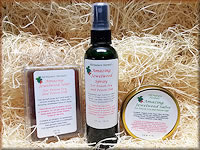
Try Amazing Jewelweed Soap, Salve and/or Spray
Amazing Jewelweed Kit
as shown, 36.95
Soap, Salve and Spray also sold separately.
More Info

